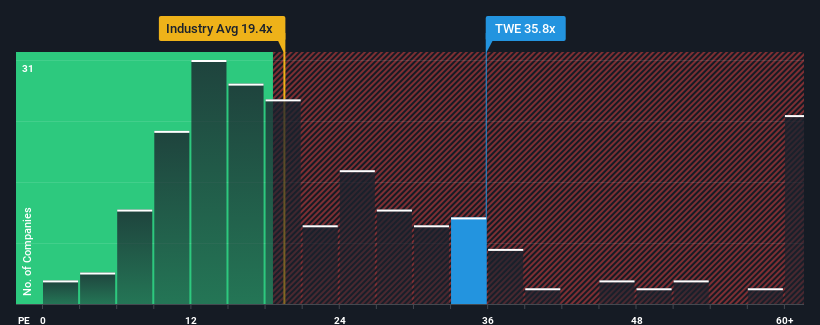Treasury Wine Estates Limited (ASX:TWE) Not Lagging Market On Growth Or Pricing
With a price-to-earnings (or "P/E") ratio of 35.8x Treasury Wine Estates Limited (ASX:TWE) may be sending very bearish signals at the moment, given that almost half of all companies in Australia have P/E ratios under 18x and even P/E's lower than 9x are not unusual. Nonetheless, we'd need to dig a little deeper to determine if there is a rational basis for the highly elevated P/E.
Treasury Wine Estates has been struggling lately as its earnings have declined faster than most other companies. It might be that many expect the dismal earnings performance to recover substantially, which has kept the P/E from collapsing. If not, then existing shareholders may be very nervous about the viability of the share price.
View our latest analysis for Treasury Wine Estates

What Are Growth Metrics Telling Us About The High P/E?
There's an inherent assumption that a company should far outperform the market for P/E ratios like Treasury Wine Estates' to be considered reasonable.
Retrospectively, the last year delivered a frustrating 3.3% decrease to the company's bottom line. The last three years don't look nice either as the company has shrunk EPS by 8.0% in aggregate. Therefore, it's fair to say the earnings growth recently has been undesirable for the company.
Turning to the outlook, the next three years should generate growth of 26% each year as estimated by the analysts watching the company. That's shaping up to be materially higher than the 17% per annum growth forecast for the broader market.
In light of this, it's understandable that Treasury Wine Estates' P/E sits above the majority of other companies. Apparently shareholders aren't keen to offload something that is potentially eyeing a more prosperous future.
What We Can Learn From Treasury Wine Estates' P/E?
While the price-to-earnings ratio shouldn't be the defining factor in whether you buy a stock or not, it's quite a capable barometer of earnings expectations.
We've established that Treasury Wine Estates maintains its high P/E on the strength of its forecast growth being higher than the wider market, as expected. Right now shareholders are comfortable with the P/E as they are quite confident future earnings aren't under threat. It's hard to see the share price falling strongly in the near future under these circumstances.
It's always necessary to consider the ever-present spectre of investment risk. We've identified 3 warning signs with Treasury Wine Estates (at least 1 which shouldn't be ignored), and understanding these should be part of your investment process.
You might be able to find a better investment than Treasury Wine Estates. If you want a selection of possible candidates, check out this free list of interesting companies that trade on a low P/E (but have proven they can grow earnings).
Valuation is complex, but we're here to simplify it.
Discover if Treasury Wine Estates might be undervalued or overvalued with our detailed analysis, featuring fair value estimates, potential risks, dividends, insider trades, and its financial condition.
Access Free AnalysisHave feedback on this article? Concerned about the content? Get in touch with us directly. Alternatively, email editorial-team (at) simplywallst.com.
This article by Simply Wall St is general in nature. We provide commentary based on historical data and analyst forecasts only using an unbiased methodology and our articles are not intended to be financial advice. It does not constitute a recommendation to buy or sell any stock, and does not take account of your objectives, or your financial situation. We aim to bring you long-term focused analysis driven by fundamental data. Note that our analysis may not factor in the latest price-sensitive company announcements or qualitative material. Simply Wall St has no position in any stocks mentioned.
About ASX:TWE
Treasury Wine Estates
Operates as a wine company in Australia, the United States, the United Kingdom, and internationally.
Very undervalued with solid track record and pays a dividend.
Similar Companies
Market Insights
Community Narratives




